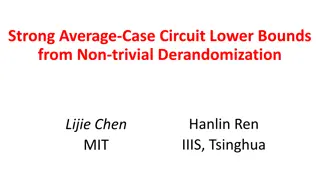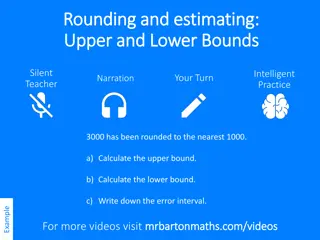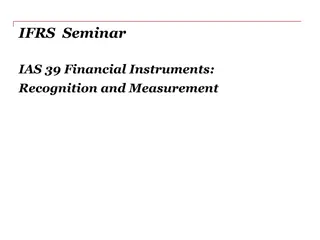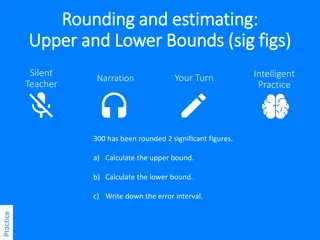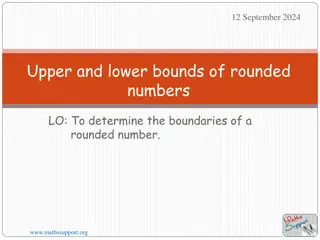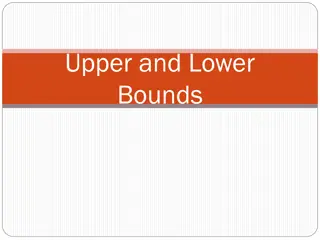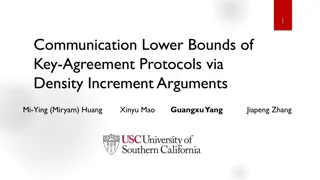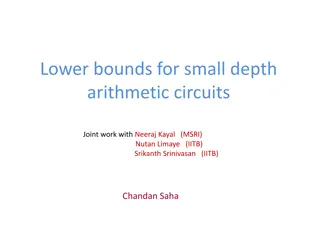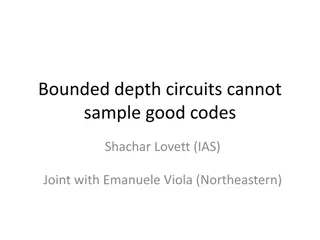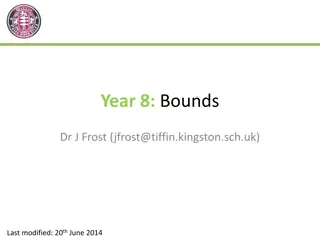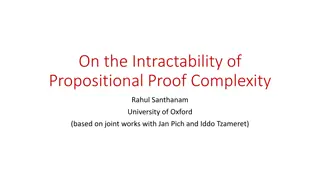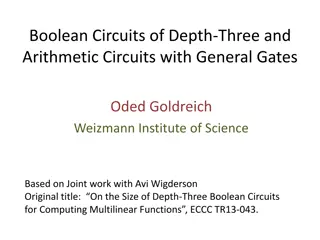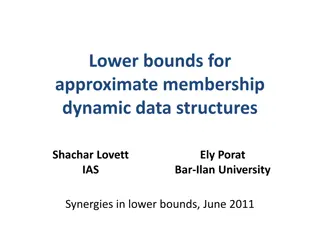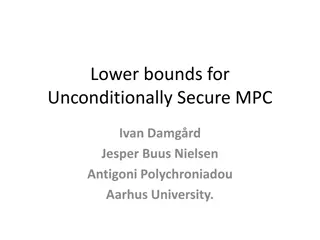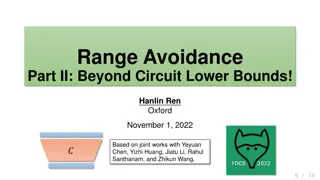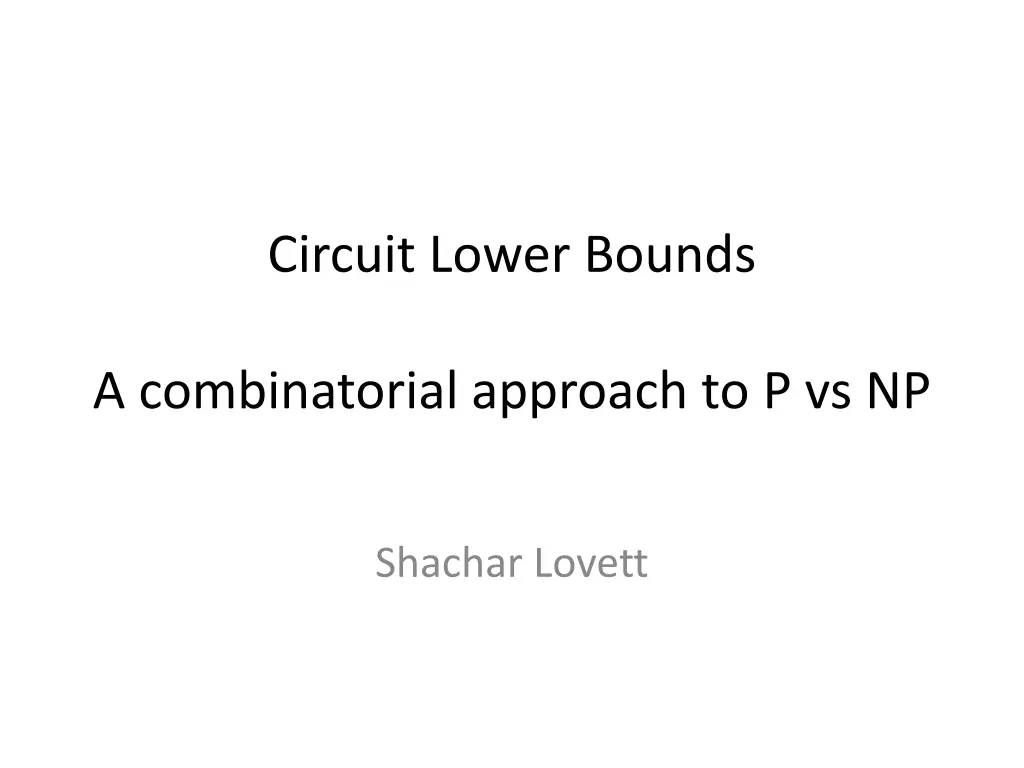
Exploring Circuit Lower Bounds and NP Complexity Theory
"Delve into the world of circuit lower bounds and computational complexity theory with a focus on P vs. NP, combinatorial approaches, algorithm-circuit comparisons, and proving computational problems' complexities. Learn about monotone circuits, bounded depth circuits, and the quest to show the limitations of circuit models in solving NP problems."
Uploaded on | 0 Views
Download Presentation

Please find below an Image/Link to download the presentation.
The content on the website is provided AS IS for your information and personal use only. It may not be sold, licensed, or shared on other websites without obtaining consent from the author. If you encounter any issues during the download, it is possible that the publisher has removed the file from their server.
You are allowed to download the files provided on this website for personal or commercial use, subject to the condition that they are used lawfully. All files are the property of their respective owners.
The content on the website is provided AS IS for your information and personal use only. It may not be sold, licensed, or shared on other websites without obtaining consent from the author.
E N D
Presentation Transcript
Circuit Lower Bounds A combinatorial approach to P vs NP Shachar Lovett
Computation Input Program Code Memory Program code is constant Input has variable length (n) Run time, memory grow with input length Efficient algorithms = run time, memory poly(n)
P vs NP P = problems we can solve = efficient algorithm to find solution NP = problems we want to solve = efficient algorithm to verify solution Examples: graph 3-coloring, satisfiability ,
Challenge How can you prove that some computational problems require >> polynomial time? In particular, one in NP Combinatorial approach: circuits Replace uniform computation by a more combinatorial object
Circuits Complex computation = iteration of many small simple computations Majority(X,Y,Z) OR AND AND AND x Y Z
Circuits Complex computation = iteration of many small simple computations Simple = any complete basis (e.g. AND,OR,NOT) f(X1, ,Xn) x1x2x3x4x5x6x7x8 xn
Algorithms vs circuits f(X1, ,Xn) Input Code Memory x1 x2 x3 x4 x5 x6 x7 x8 xn Circuits are as powerful* as algorithms: Problems with efficient (poly-time) algorithms also have poly-size circuits Revised challenge: show poly-size circuits cannot solve all interesting computational problems
Lower bounds Goal: show poly-size circuits cannot solve NP Can prove lower bounds for restricted circuit models Monotone circuits Bounded depth circuits General technique: 1. Approximate circuit by a nice mathematical model 2. Show the mathematical model cannot solve the problem (not even approximately)
Monotone circuits Monotone circuits: circuits with just AND-OR gates (no NOT gates) Compute monotone functions (e.g clique) Can clique have poly-size monotone circuits? [Razborov 85, Alon-Boppana 87]: No. Clique requires exponential size monotone circuits
Monotone circuits Input: n edges of graph G on m n1/2 vertices Output: does G have large clique? Circuit: poly-size with AND-OR gates Step 1: approximate AND-OR circuit by lattice Step 2: show lattice cannot approximate clique f(X1, ,Xn) x1x2x3x4x5x6x7x8 x n
Bounded depth circuits Small depth = parallel computation Efficient algorithms = poly(n) depth Can prove lower bounds for depth << log(n) f(X1, ,Xn) depth x1x2x3x4x5x6x7x8 xn
Lower bounds for AND-OR-NOT circuits Parity(x1, ,xn) = sum of bits modulo 2 Computed by small AND-OR-NOT circuits of depth log(n) Can the depth be reduced, while maintaining small size? [Ajtai 83, Furst-Saxe-Sipser 84]: No. small (sub- exponential) AND-OR-NOT circuits of depth <<log(n) cannot compute parity [Yao 85, Hastad 86]: not even approximately
Lower bounds for AND-OR-NOT circuits Main idea: random restrictions of input set most inputs bits to random 0,1 values; leave remaining variables alive AND Simple computations: AND, OR, NOT X1 Xn Gates with many inputs are fixed by random restriction Iterate to make entire circuit simple (decision tree) Parity doesn t simplify (becomes parity of fewer inputs)
Lower bounds for AND-OR-NOT- PARITY circuits What if we also allow parity gates as simple computations? MOD3(x1, ,xn) = sum of bits modulo 3 Intuition: parities shouldn t help compute MOD3 [Razborov 87, Smolensky 87]: small (sub- exponential) AND-OR-NOT-PARITY circuits of depth <<log(n) cannot compute MOD3
Lower bounds for AND-OR-NOT- PARITY circuits Local computation: AND, OR, NOT, PARITY Random restrictions fail: don t simplify parity Can approximate local computations by low- degree polynomials modulo 2 (and by composition, approximate the entire circuit) Low degree polynomials modulo 2 cannot compute MOD3
Lower bounds for AND-OR-NOT- PARITY-MOD3 circuits What if we allow both PARITY and MOD3 gates as simple computation? Conjecture: cannot compute MOD5 in small size and depth <<log(n) [Williams 10]: cannot compute all NEXP - exponential analog of NP (problems whose solution can be verified in exponential time)



